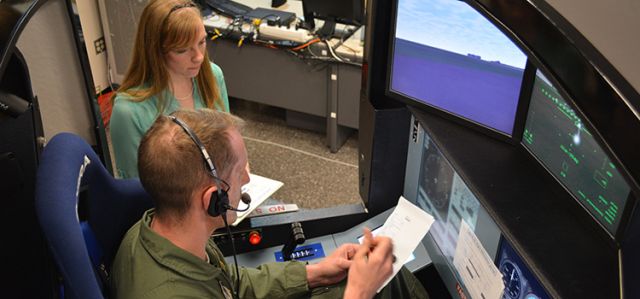Aspiration Efficiencies of a Soot-Particulate Sampling Probe with Dilution Under Gas Turbine Conditions
Document Type
Conference Paper
Publication Date
7-2008
Publication Source
44th AIAA/ASME/SAE/ASEE Joint Propulsion Conference & Exhibit
Abstract
An extensive numerical investigation is conducted to quantify the aspiration efficiency (Aeff) of a soot-particulate sampling probe with dilution under ground idle and normal rated power gas-turbine conditions. The axisymmetric turbulent air flow around and inside the cone-shaped probe is simulated by employing the steady RNG k-ε RANS governing equations. The probe external flow field is measured in a Low Speed Wind Tunnel using Particle Image Velocimetry (PIV) and the measurements provided excellent qualitative and quantitative agreements with the numerical results. A steady, one-way coupling Lagrangian approach is used to track the particles, whose trajectory depends on the balance between the particle inertia and flow drag forces.
A range of conditions from sub- to super-isokinetic sampling were examined by varying the dilution ratio (φ). The flow field ahead of the probe first diverges and then converges near the probe orifice for low dilution ratios (φeff) of unity for particle Stokes numbers (St) equal or less than 5×10-3 regardless of the gas turbine conditions. With increasing St, Aeff increases monotonically until it reaches a maximum value for any condition at φ≥80%. For φeff first decreases with increasing St due to the sub-isokinetic flow pattern ahead of the probe. However, with further increase in St, Aeff increases until it reaches a maximum value. At a constant φ, with increasing the gas-turbine exhaust flow velocity (Uo), Aeff increases for St>5×10-3. On the contrary, with increasing the gas-turbine exhaust flow temperature (To) Aeff decreases. Comparison with the current study shows that the Belyaev-Levin's equation generally overestimates Aeff for moderate St, but it underestimates Aeff for high St. At moderate St, our cone-shaped probe is less sensitive to variations in both St and velocity ratio (R) than its corresponding thin-walled probe, depicted by the Belyaev-Levin's equation. At high St, particle bouncing occurs, increasing Aeff above that predicted by the Belyaev-Levin's equation. Moreover, a theoretical equation has been derived that correlates R as a function of φ, which compares remarkably well with the numerical results. In addition, the Saffman's lift force and gravitational force have no effect on Aeff for the current conditions. Furthermore, we found that soot-particle sampling at ground idle and normal rated power conditions is highly efficient with our cone-shaped probe.
ISBN/ISSN
978-1-60086-992-1
Copyright
Copyright © 2008, American Institute of Aeronautics and Astronautics
Publisher
American Institute of Aeronautics and Astronautics
Place of Publication
Hartford, CT
eCommons Citation
Briones, Alejandro; Stouffer, Scott; Bichal, Abhishek; Kang, Hantae; Altman, Aaron; Corporan, Edwin; and Belovich, Vincent, "Aspiration Efficiencies of a Soot-Particulate Sampling Probe with Dilution Under Gas Turbine Conditions" (2008). Mechanical and Aerospace Engineering Faculty Publications. 89.
https://ecommons.udayton.edu/mee_fac_pub/89
COinS




Comments
Permission documentation is on file.